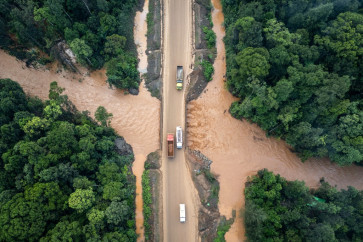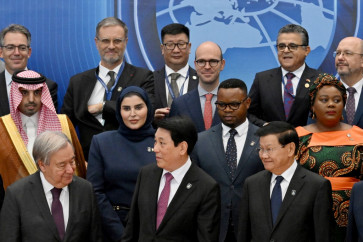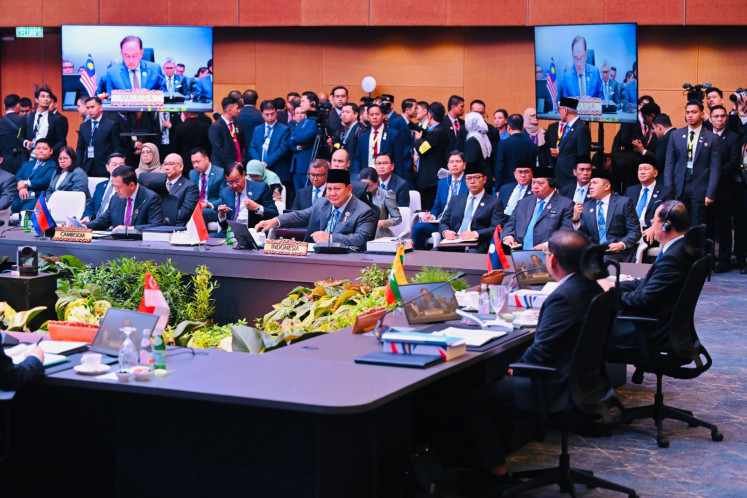Popular Reads
Top Results
Can't find what you're looking for?
View all search resultsPopular Reads
Top Results
Can't find what you're looking for?
View all search resultsRevisiting development: Have we assessed it correctly?
Behind impressive macroeconomic fundamentals lies a very different picture of Indonesia
Change text size
Gift Premium Articles
to Anyone
B
ehind impressive macroeconomic fundamentals lies a very different picture of Indonesia. Two thirds of Indonesian children under five years old suffer from stunted growth, according to Health Ministry data in 2010, which means that they suffer from some irreversible cognitive and physical deficiencies.
In 2009, more than 50 percent of Indonesians lived on less than US$2 per day (in PPP terms). In 2010, the average years of schooling for adults aged 25 years old and above was 5.7 years, while Malaysia’s was 9.5 years and China’s was 7.5 years.
Youth unemployment stood at 21 percent with most employment in the informal sector. Is the ‘strong’ economic picture only a chimera?
We need to revisit how we assess development. Development is multidimensional — from quality of education, governance, child nutrition, social capitalism to human rights, justice and security. Despite a seemingly strong economic performance, we seem to be suffering from many socio-economic issues: Child malnutrition; high infant and maternal mortality; poor education; the recent alleged abuses of human rights in land and mining conflicts; social resistance to injustice and ineffective government; regional conflicts in Aceh and Papua; to ethnic and religious minority tensions that threaten freedom of religion.
Sadly, children can be easily deprived of moral values if they become so accustomed to corrupt practices, abuses of human rights, and so much injustice that it becomes the norm rather than being an anomaly.
Health and the environment are also other noteworthy issues, especially because our children’s futures rely on their development — their body and mind.
Quite apart from poor people, even those who can afford high-quality medical treatment often cannot get good and reliable health care in Indonesia.
Having a healthy environment — lots of open parks, clean air, good hygiene and good health care personnel (medical doctors and nurses) and choices of healthy food are keys to good development for our children. No less important is their peace of mind.
But, why is it a chimera?
First, looking at the structure of our economy, it is questionable whether Indonesia is resilient to external shocks because of “good luck” or “good management”. About 60 percent of our economy comes from domestic consumption. The financial sector is still a relatively small part of the economy and under-developed in comparison to other countries within the same income category.
Most of all, we were saved by the painful structural reform during and after the Asian Financial Crisis in 1997. David Lipton, First Deputy Managing Director of the IMF, recently stated that “From the vantage point of 2012, one can see that the reforms taken during and after that difficult and traumatic period gave Asia the resilience to withstand the 2008 global financial crisis and are helping today.” But, do we need it to get worse in order to get better?
Second, economic growth is a necessity but not a sufficient condition to improving well-being. It is a tool for development, but not an end to development.
Often, we take a “short-cut” to assess development, such as GDP growth. Indonesia’s investment upgrade by credit rating agencies (CRA) should not be played up.
Measuring the accuracy of credit ratings is very difficult and complex, even with hindsight, as they correspond to probabilities.
This was evident during the 2008 Global Financial Crisis (GFC), when the credit rating agencies failed to point out the high risk of default of the sub-prime mortgage-based securities and other collateralized debt obligations.
After the 2008 GFC, some critics even blamed conflicts of interest, as rating agencies are paid by the firms that organize and sell the debt to investors, including investment banks. As a part of global financial regulatory reform, the Financial Stability Board has already asked its member countries to reduce reliance on CRA.
Third, poor institutions may undermine the ‘trickle down’ effect. Some studies show that institutions are needed to transform the benefits of economic growth into development in the real sector.
The transformation must be supported by the ability to build infrastructure, strong rule of law and good governance. “Miraculous” stories are found in the East Asian newly industrialized economies, namely Singapore, South Korea, Hong Kong, and Taiwan.
Hence, in the long run, without improvement in its soft and hard institutions, it is unlikely that high economic growth will bring Indonesia a better quality of life in the future.
A vibrant society needs to be critical. No one wants to spoil a good time such as Indonesia is enjoying right now. Unfortunately, economic crises often come at the least expected moment like in 1997 and 2008. Politicians are often constrained from telling the whole story, but populist statements may distort the real picture.
Therefore, a vibrant society must remain alert, critical and sensitive to socio-economic issues and not be easily duped by impressive numbers. After all, what we need is quality growth, and not a sub-optimal or stunted one.
The writer is a researcher at the Centre for Strategic and International Studies in Jakarta and a lecturer at the University of Indonesia’s School of Economics.










